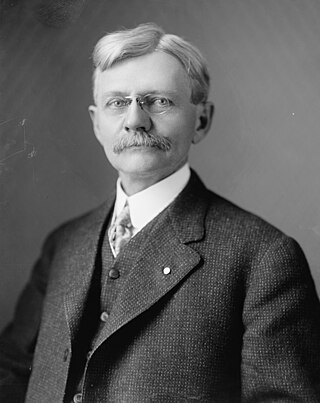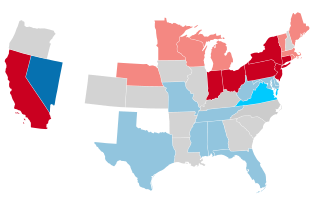
Thomas Riley Marshall was an American politician who served as the 28th vice president of the United States from 1913 to 1921 under President Woodrow Wilson. A prominent lawyer in Indiana, he became an active and well known member of the Democratic Party by stumping across the state for other candidates and organizing party rallies that later helped him win election as the 27th governor of Indiana. In office, he attempted to implement changes from his progressive agenda to the Constitution of Indiana, but his efforts proved controversial and were blocked by the Indiana Supreme Court.

Thomas Andrews Hendricks was an American politician and lawyer from Indiana who served as the 16th governor of Indiana from 1873 to 1877 and the 21st vice president of the United States from March until his death in November 1885. Hendricks represented Indiana in the U.S. House of Representatives (1851–1855) and the U.S. Senate (1863–1869). He also represented Shelby County, Indiana, in the Indiana General Assembly (1848–1850) and as a delegate to the 1851 Indiana constitutional convention. In addition, Hendricks served as commissioner of the United States General Land Office (1855–1859). Hendricks, a popular member of the Democratic Party, was a fiscal conservative. He defended the Democratic position in the U.S. Senate during the American Civil War and Reconstruction era and voted against the Thirteenth, Fourteenth, and Fifteenth Amendments to the U.S. Constitution. He also opposed Radical Reconstruction and President Andrew Johnson's removal from office following Johnson's impeachment in the U.S. House.

The governor of Indiana is the head of government of the U.S. state of Indiana. The governor is elected to a four-year term and is responsible for overseeing the day-to-day management of the functions of many agencies of the Indiana state government. The governor also shares power with other statewide executive officers, who manage other state government agencies. The governor works out of the Indiana Statehouse and holds official functions at the Indiana Governor's Residence in the state capital of Indianapolis.

The Indiana General Assembly is the state legislature, or legislative branch, of the U.S. state of Indiana. It is a bicameral legislature that consists of a lower house, the Indiana House of Representatives, and an upper house, the Indiana Senate. The General Assembly meets annually at the Indiana Statehouse in Indianapolis.

Oliver Hazard Perry Throck Morton, commonly known as Oliver P. Morton, was a U.S. Republican Party politician from Indiana. He served as the 14th governor of Indiana during the American Civil War, and was a stalwart ally of President Abraham Lincoln. Morton worked hard to maximize Indiana's contribution to the war effort and marginalize the obstructionists. He was a principled and effective leader who fought for equality and nationalism through the use of governmental power. His forceful pursuit of civil rights and prosecution of Copperheads and white supremacists gained him lasting enemies among the antiwar elements. Morton thwarted and neutralized the Democratic-controlled Indiana General Assembly. He exceeded his constitutional authority by calling out the militia without approval, and during the period of legislative suppression he privately financed the state government through unapproved federal and private loans. He was criticized for arresting and detaining political enemies and suspected southern sympathizers. As one of President Lincoln's "war governors", Morton made significant contributions to the war effort, more than any other man in the state, and earned the lifelong gratitude of former Union soldiers for his support.
New York is a Democratic stronghold and is considered one of the "Big Three" Democratic strongholds alongside California and Illinois. The following table indicates the party of elected officials in the U.S. state of New York:

Joseph Albert Wright was the tenth governor of the U.S. state of Indiana from December 5, 1849, to January 12, 1857, most noted for his opposition to banking. His positions created a rift between him and the Indiana General Assembly who overrode all of his anti-banking vetoes. He responded by launching legal challenges to the acts, but was ruled against by the Indiana Supreme Court. The state's second constitutional convention was held during 1850–1851 in which the current Constitution of Indiana was drafted. He was a supporter of the new constitution and gave speeches around the state urging its adoption. He was opposed throughout his term by Senator Jesse D. Bright, the leader of the state Democratic Party.

Ashbel Parsons Willard was state senator, the 12th lieutenant governor, and the 11th governor of the U.S. state of Indiana. His terms in office were marked by increasingly severe partisanship leading to the breakup of the state Democratic Party in the years leading up to the American Civil War. His brother-in-law John Edwin Cook was involved in John Brown's raid on Harpers Ferry, and was executed. Willard went to the south to advocate unsuccessfully for his release, and became despised by southerners who accused him of having a secret involvement in the raid. He died two months before the start of the war while giving a speech on national unity, and was the first governor of Indiana to die in office.

Isaac Pusey Gray was the 18th and 20th governor of the U.S. state of Indiana from 1880 to 1881 and from 1885 to 1889. Originally a Republican, he oversaw the forceful passage of the post-American Civil War constitutional amendments while he was a member of the Indiana Senate. He became a Democrat following the corruption of the Administration of Ulysses S. Grant but was regularly stymied by his Democratic adversaries who constantly referred to his tactics while a Republican, earning him the nickname "Sisyphus of the Wabash."

Claude Matthews was an American politician who served as the 23rd governor of the U.S. state of Indiana from 1893 to 1897. A farmer, he was nominated to prevent the loss of voters to the Populist Party. The Panic of 1893 occurred just before he took office, leading to severe economic problems during his term. Republicans took the Indiana General Assembly in the 1894 mid-term election and repudiated many of the Democrats' laws, leading to violence in the assembly. A popular party figure when he left office, he was a nominee to run for president at the 1896 Democratic National Convention, but lost his bid for the nomination to William Jennings Bryan.

Henry Frederick Schricker was an American politician who served as the 36th and 38th Governor of the U.S. state of Indiana from 1941 to 1945 and from 1949 to 1953. He is the only Indiana governor elected to two non-consecutive terms, and the only governor between 1852 and 1977 to be elected to more than one term in office. His terms were marked by strong opposition party control of the Indiana General Assembly, which attempted to remove powers from the governor that had been granted during the Great Depression. Schricker fought the attempt in the state courts, and although his power was significantly reduced, the Indiana Supreme Court ruled in the case of Tucker v. Indiana that the governor was the chief executive of the state, and the legislature could not pass legislation that interfered with the division of powers.

Harold Willis Handley was the 40th governor of the U.S. state of Indiana from 1957 to 1961. A veteran of World War II, and furniture salesman by trade, Handley began his political career as a state senator. Thanks to his longtime friendship with state party leader and United States Senator William E. Jenner, he was able to secure the nomination to run for lieutenant governor in 1952, during which time he opposed many of the actions of Governor George N. Craig. His popularity rose among the conservative leadership of the Indiana Republican Party and aided him in winning the nomination and subsequent election as governor in 1956.

The Louisiana State Senate is the Upper House of the State Legislature of Louisiana. All senators serve four-year terms and are assigned to multiple committees.

The Democratic Party of Indiana is the affiliate of the Democratic Party in the U.S. state of Indiana. The party's chair is Mike Schmuhl.

The lieutenant governor of Indiana is a constitutional office in the US state of Indiana. Republican Suzanne Crouch, who assumed office January 9, 2017, is the incumbent. The office holder's constitutional roles are to serve as the president of the Indiana Senate, become acting governor during the incapacity of the governor, and become governor should the incumbent governor resign, die in office, or be impeached and removed from office. Lieutenant governors have succeeded ten governors following their deaths or resignations. The lieutenant governor holds statutory positions, serving as the head of the state agricultural and rural affairs bureaus, and as the chairman of several state committees.

The 1874–75 United States Senate elections were held on various dates in various states. As these U.S. Senate elections were prior to the ratification of the Seventeenth Amendment in 1913, senators were chosen by state legislatures. Senators were elected over a wide range of time throughout 1874 and 1875, and a seat may have been filled months late or remained vacant due to legislative deadlock. In these elections, terms were up for the senators in Class 1.

The 1880–81 United States Senate elections were held on various dates in various states, coinciding with the presidential election of 1880. As these U.S. Senate elections were prior to the ratification of the Seventeenth Amendment in 1913, senators were chosen by state legislatures. Senators were elected over a wide range of time throughout 1880 and 1881, and a seat may have been filled months late or remained vacant due to legislative deadlock. In these elections, terms were up for the senators in Class 1.

The 177th New York State Legislature, consisting of the New York State Senate and the New York State Assembly, met from January 4, 1967, to May 25, 1968, during the ninth and tenth years of Nelson Rockefeller's governorship, in Albany.
Alonzo Greene Smith was a politician from the U.S. state of Indiana. Between 1886 and 1889 he served as acting Lieutenant Governor of Indiana.

An election for the United States Senate was held by the Pennsylvania General Assembly beginning on January 17, 1899, to fill the seat then held by Matthew Quay for a six-year term beginning March 4, 1899. Quay was a candidate for re-election, but he was damaged by a pending indictment for involvement in financial irregularities with state money; his trial took place during the three months that the legislature attempted to resolve the Senate deadlock, and he was acquitted the day it adjourned, having failed to elect a senator. Quay was appointed to the Senate seat by the governor, but the Senate refused to seat him on the grounds that the governor lacked the constitutional authority to make the selection, and the seat remained vacant until the next meeting of the legislature, in 1901, when Quay was elected.






















